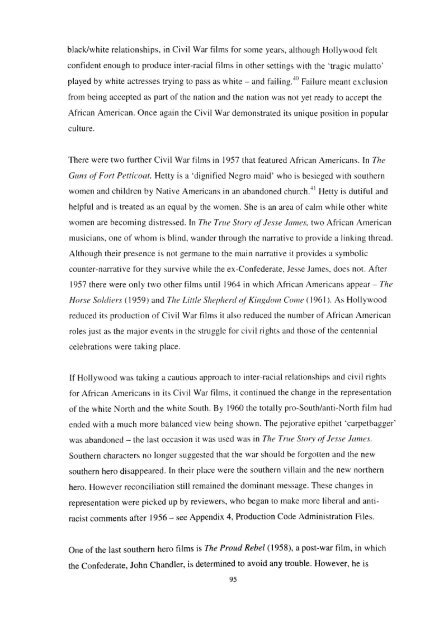Download (3483kB) - Greenwich Academic Literature Archive ...
Download (3483kB) - Greenwich Academic Literature Archive ...
Download (3483kB) - Greenwich Academic Literature Archive ...
- No tags were found...
Create successful ePaper yourself
Turn your PDF publications into a flip-book with our unique Google optimized e-Paper software.
lack/white relationships, in Civil War films for some years, although Hollywood feltconfident enough to produce inter-racial films in other settings with the 'tragic mulatto'played by white actresses trying to pass as white - and failing. 40 Failure meant exclusionfrom being accepted as part of the nation and the nation was not yet ready to accept theAfrican American. Once again the Civil War demonstrated its unique position in popularculture.There were two further Civil War films in 1957 that featured African Americans. In TheGuns of Fort Petticoat, Hetty is a 'dignified Negro maid' who is besieged with southernwomen and children by Native Americans in an abandoned church. 41 Hetty is dutiful andhelpful and is treated as an equal by the women. She is an area of calm while other whitewomen are becoming distressed. In The True Story of Jesse James, two African Americanmusicians, one of whom is blind, wander through the narrative to provide a linking thread.Although their presence is not germane to the main narrative it provides a symboliccounter-narrative for they survive while the ex-Confederate, Jesse James, does not. After1957 there were only two other films until 1964 in which African Americans appear- TheHorse Soldiers ( 1959) and The Little Shepherd of Kingdom Come (1961). As Hollywoodreduced its production of Civil War films it also reduced the number of African Americanroles just as the major events in the struggle for civil rights and those of the centennialcelebrations were taking place.If Hollywood was taking a cautious approach to inter-racial relationships and civil rightsfor African Americans in its Civil War films, it continued the change in the representationof the white North and the white South. By 1960 the totally pro-South/anti-North film hadended with a much more balanced view being shown. The pejorative epithet 'carpetbagger'was abandoned - the last occasion it was used was in The True Story of Jesse James.Southern characters no longer suggested that the war should be forgotten and the newsouthern hero disappeared. In their place were the southern villain and the new northernhero. However reconciliation still remained the dominant message. These changes inrepresentation were picked up by reviewers, who began to make more liberal and anti-racist comments after 1956 - see Appendix 4, Production Code Administration Files.One of the last southern hero films is The Proud Rebel (1958), a post-war film, in whichthe Confederate, John Chandler, is determined to avoid any trouble. However, he is95
















